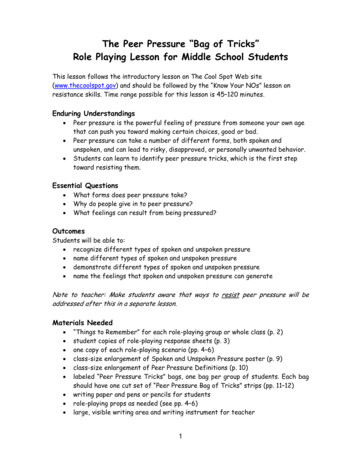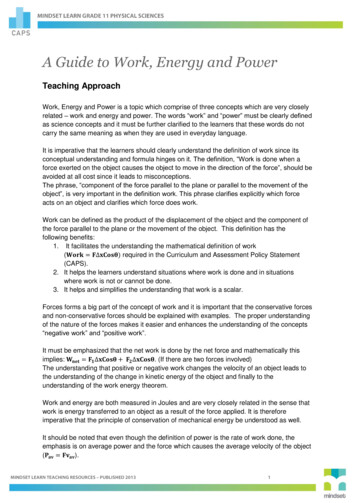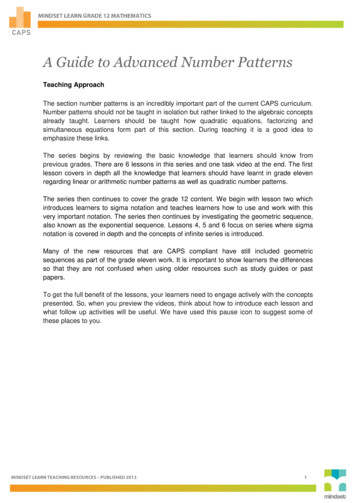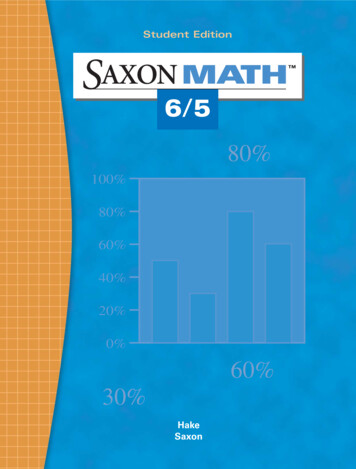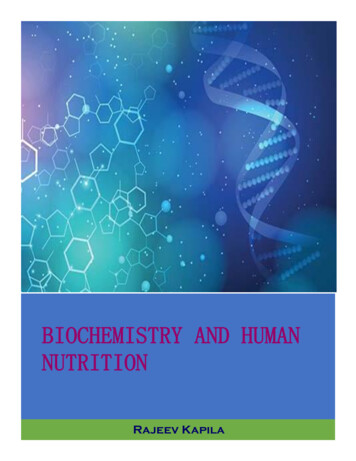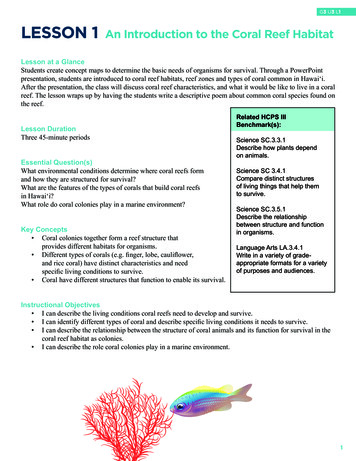
Transcription
G3 U3 L1LeSSON 1An introduction to the Coral Reef HabitatLesson at a GlanceStudents create concept maps to determine the basic needs of organisms for survival. Through a PowerPointpresentation, students are introduced to coral reef habitats, reef zones and types of coral common in Hawai‘i.After the presentation, the class will discuss coral reef characteristics, and what it would be like to live in a coralreef. The lesson wraps up by having the students write a descriptive poem about common coral species found onthe reef.Lesson DurationThree 45-minute periodsEssential Question(s)What environmental conditions determine where coral reefs formand how they are structured for survival?What are the features of the types of corals that build coral reefsin Hawai‘i?What role do coral colonies play in a marine environment?Key Concepts Coral colonies together form a reef structure thatprovides different habitats for organisms. Different types of corals (e.g. finger, lobe, cauliflower,and rice coral) have distinct characteristics and needspecific living conditions to survive. Coral have different structures that function to enable its survival.Related HCPS IIIBenchmark(s):Science SC.3.3.1Describe how plants dependon animals.Science SC 3.4.1Compare distinct structuresof living things that help themto survive.Science SC.3.5.1Describe the relationshipbetween structure and functionin organisms.Language Arts LA.3.4.1Write in a variety of gradeappropriate formats for a varietyof purposes and audiences.Instructional Objectives I can describe the living conditions coral reefs need to develop and survive. I can identify different types of coral and describe specific living conditions it needs to survive. I can describe the relationship between the structure of coral animals and its function for survival in thecoral reef habitat as colonies. I can describe the role coral colonies play in a marine environment.1
G3 U3 L1Assessment ToolsBenchmark Rubric:TopicBenchmark SC.3.3.1RubricAdvancedClassify plants by theirdependence on animals.InterdependenceDescribe how plants depend on animalsProficientDescribe how plantsdepend on animals.TopicProficientCompare distinct structuresof living things that helpthem to surviveTopicProficientDescribe the relationshipbetween structure andfunction in organismsTopic2NoviceName distinct structures ofliving things that help themto survivePartially ProficientIdentify the relationshipbetween structure andfunction in an organismNoviceRecall that structures inorganisms are related tothe functions they performRange of WritingWrite in a variety of grade-appropriate formats for avariety of purposes and audiences, such as: stories with a beginning, middle, and end and poemswith sensory details short reports on content area topics pieces related to completing tasks friendly letters responses to literature pieces to reflect on learning and to solve problemsBenchmark LA.3.4.1RubricAdvancedInsightfully adapt writing tograde-appropriate formatsfor a variety of purposesand audiencesPartially ProficientDescribe a few ways inwhich distinct structures ofliving things help them tosurviveUnity and DiversityDescribe the relationship between structure andfunction in organismsBenchmark SC.3.5.1RubricAdvancedClassify the structures oforganisms according totheir functionNoviceRecognize that plantsdepend on animals.Cells, Tissues, Organs, and Organ SystemsCompare distinct structures of living things that helpthem to surviveBenchmark SC.3.4.1RubricAdvancedGroup living things by thedistinct structures thathelp them to survive andprovide justification for thegroupingPartially ProficientName very few ways inwhich plants depend onanimals.ProficientAdapt writing to gradeappropriate formats for avariety of purposes andaudiencesPartially ProficientWrite with some adaptationto grade-appropriateformats for a variety ofpurposes and audiencesNoviceWrite with little adaptationto grade-appropriateformats for a variety ofpurposes and audiences
G3 U3 L1Assessment/Evidence PiecesThis lesson serves as an introduction and is not for assessment. Some formativeassessments may be made using the following:Lesson Class – discussion on PowerPoint Class – completion and discussion of Corals of Hawai‘i worksheet Class- discussion on relationship of individual coral animals and colonial reefs Coral Reef PoemMaterials Needed TeacherChart Paper ClassNone GroupNone StudentNoneMethod to presentPowerPointInstructional ResourcesPowerPoint Presentation: Coral Reef HabitatPowerPoint Presentation: Adaptations for Living on a ReefStudent Worksheet: Corals of Hawai‘iStudent Reading: Poetry ExamplesStudent Reading: Reef Types (Optional)Student Vocabulary Wordsadaptations: special traits that help living organisms survive in a particular environment.atolls: ringed coral reef island enclosing a lagoon.back reef: commonly called the lagoon of a coral reef, it lies immediately shoreward of the innermost marginof the reef crest zone, and extends all the way to the shore.barrier reef: reef separated from the land mass by a lagoon.benthic: occurring on the bottom of a body of water.cauliflower coral (Pocillopora meandrina): a common reef building coral species in Hawaiian reefs; branchingcoral with a cauliflower-like shape; found in areas with strong currents and wave action.colonies: groups of individuals living together, usually genetically identical, asexual clones.coral reef zones: the different areas of a coral reef determined by exposure to sunlight, water depth, currents,and wave surge. A typical coral reef includes beach, lagoon, reef crest, fore reef, and back reef zones.finger coral (Porites compressa): a common reef-building coral species in Hawaiian reefs; columnar shape withmany finger-like branches; found in areas protected from waves.fore reef: often called the “reef front” begins at the seaward base of the reef crest.fringing reef: coral reefs that form directly adjacent to a land mass.habitat: the place, or environment in which a plant or animal naturally lives and grows.lagoon: a shallow body of water separated from the ocean possibly by a barrier reef or sandbar.lobe coral (Porites lobata): a common reef-building coral species on Hawaiian reefs; it forms massive colonieswith lobed branches; olive-green, brown, yellowish-light green, or blue-gray color; found in wave-exposed areas.patch reef: an isolated coral growth forming a small platform in a lagoon, barrier reef, or atoll.3
G3 U3 L1reef crest: the highest (most shallow) part of the reef, and lies between the shoreward, protected back reef zoneand the outer fore reef zone.reef flat: area of high land impacts and low wave energy on the fringing reef.reef slope: area of high coral cover and moderate to low wave energy on the fringing reef.rice coral (Montipora capitata): a common reef building coral species in Hawaiian reefs; branching, plate-like,or encrusting shape; white, white with brownish coating, or blue coloration; found in all reef environments(except the branching form, which lives where it is protected from waves).seagrass: various grass-like plants that inhabit coastal areas.survival: the ability to stay alive. Often aided by adaptations that can be passed on to offspring and evolve overmany generations.Lesson PlansLesson Preparation Review the Science Background provided in the Unit Overview. Preview PowerPoint presentations Coral Reef Habitat and Adaptations for Living on a Reef. Makearrangements to project them. Make copies of the Student Worksheet on Corals of Hawai‘i and the Student Readings Poetry Examplesand Reef Types, one for each student. Print out pictures of coral reef organisms for Section 1 Part A below. Pictures of coral reef organismsmay be found at http://www.photolib.noaa.gov/brs/rfind13.htm Make a large Venn Diagram on a piece of chart paper. Make a large matrix on the chalk or white board.4I. Survival in the Coral Reef HabitatA. Identify basic needs for organisms to survive.1. Draw a large (two ring) Venn Diagram on the board. Place students in an area where they haveroom to mingle amongst each other. Give each student a picture of a coral reef organism (i.e. goatfish,forcepsfish, butterflyfish, damselfish or “mamo”, cleaner wrasse, parrotfish, yellow tang, MoorishIdol, Humuhumunukunukuapua’a, porcupinefish) or a mammal (i.e. human, dog, cat, monkey, rabbit,lion, deer, horse, etc.) and ask students to first make observations of their own organism.2. On your signal ask students to move amongst each other and make observations of the differentorganism each student has. Give a signal for students to stop. Ask students that if they were to considerall of these organisms as one big group, what characteristics do all of these organisms have incommon? Through questioning and discussion, guide students to identify that they are all living andhave basic needs for survival, which includes: air, food, water, sunlight, space, shelter, and the rightrange of temperature. List these needs in the middle of the Venn diagram.B. Identify structures and their functions that enable organisms to survive.1. Ask students, if they now had to sort themselves into two groups, which organisms would belong ineach group? Guided questioning and discussion may be necessary to assist the students with sortingthemselves into the two groups.2. Ask students what we would call the group that consists of humans, dogs, deer, etc. When theappropriate answer is given, label the left ring of the Venn diagram with “Mammal.” Then ask studentsto identify what mammals have that are in common. Again, with guided questioning and discussion,have students identify the following characteristics: warm blooded, have hair or fur, four limbs, babiesborn live, and breathe air with lungs. List these characteristics on the Mammal side of the Venn diagram.3. Repeat the above procedure to identify and characterize “Fishes”: are cold blooded, have scales, finsand a tail, lay eggs and breathe through gills. “Fishes” and their characteristics should be listed on theright side of the diagram.
G3 U3 L14.5.Explain to the students that different organisms have different body parts or “structures,” to meet thebasic needs all organisms have in common. For example, humans have arms and legs and fish havefins and tails. These “structures” which “function” to help them to survive are called “adaptations.”Explain that the adaptations an organism has depends on where they live.Introduce the term habitat as “a specific environment that meets an organism’s needs” (ScienceSaurus,2005). Announce that for this unit of study, we will be learning about the coral reef habitat. Askstudents, “Based on what you know about this habitat, which group of organisms is best adapted forthis environment? How do you know?” Examples of student responses include: Fishes have a tail and fins to enable them to swim in the water. Fishes have compressed bodies to enable them to swim amongst the coral. Fishes have gills to breathe in water.6. Conclude by showing PowerPoint Adaptations for Living on a Reef reinforcing that organisms, likefishes, have structures that function to enable survival in a coral reef habitat.II. Types of CoralA. Handout Student Worksheet Corals of Hawai‘i to each student. Present the Coral Reef HabitatPowerPoint. Have students make notes on their worksheet as the coral information is presented.B. Review the coral reef zones. Ask students to compare the physical characteristics of each coral zone. Ask:1. Which zone receives the most sunlight?2. Which zone has the most wave action?3. What would it be like to live in each zone?C. Discuss which types of coral might live in each zone, using their knowledge of structures and theirfunctions to justify “why.”D. Reconnect to prior learning about habitats and develop students understanding that each reef zone is a uniquehabitat for plants and animals to live in, but that all zones are connected as part of the coral reef environment.E. Conclude their learning about the types of corals and their habitats by creating a class matrix. Dividestudents into four groups, according to the types of coral: lobe, finger, rice, and cauliflower. Ask studentgroups to summarize and record the physical features, characteristics of the reef zone it is found in, andwhat it looks like to post in the matrix as shown in the example below.Name of CoralPhysical FeaturesFinger Coral Long thin branches BumpyReef ZoneCharacteristicsWhat it Looks Like Fore reef Deeper WaterLobe CoralRice CoralCauliflower CoralIII. Coral PoetryA. Have students select a specific coral and write a poem about it, using the descriptions of corals listed onthe board. Poems should include a description of the features of the coral type, and the environmentalconditions of the reef zone where it lives.B. Optional resource: share student readings on “Reef Types,” which compares fringing reefs, barrier reefsand atolls (evolution of coral reefs), included in these resources as an alternative focus for poetry activity.C. Give each student a copy of the Student Reading Poetry Examples. Review Poetry Examples withstudents. This can be done as homework, or in class.D. Have students share their poems with the class.[Suggestion: If short on time then do the poetry activity during writer’s workshop sessions or languagearts time.]5
G3 U3 L1LeSSON 1Corals of Hawai‘iNAME: DATE:Lobe Coral InfoFinger Coral InfoRice Coral InfoCauliflower Coral Info6
G3 U3 L1LeSSON 1Student ReadingPoetry examplesExample of an Acrostic Poem for Finger Coral:(An acrostic poem is a poem in which special letters spell another word)Fragile branching coralIn deeper water to protect from big wavesName in Hawaiian is pōhaku punaGrowing in the fore reefEvery branch looks like a fingerReaching to the sunlightExample of a Cinquain Poem for Lobe Coral:A cinquain is a five-line poem:Line 1: one word (subject or noun)Line 2: two words (adjectives thatdescribes line 1)Line 3: three words (action verbs)that relate to line 1Line 4: four words (feelings or a completesentence) that relates to line 1Line 5: one word (synonym of line 1 or aword that sums it up)Example:LobeLarge, roundForms reef crestStrong, likes crashing wavesPunaExample of a Haiku Poem for Cauliflower Coral:(A Haiku poem consists of 3 lines; line 1 has 5 syllables, line 2 has 7 syllables and line 3 has 5 syllables.)Shaped like the veggieCauliflower coral likesStrong waves and currents7
G3 U3 L1ReeF TYPeSMost fringing reefs can be further divided from the land to the sea intothe reef flat, reef crest, and reef slope. The reef flat, located directlyadjacent to land, often receives large amounts of rain run-off, and as aresult has low coral diversity. The reef crest is the most exposed partof the fringing reef because of its exposure to high energy waves. Thereef slope extends seaward below the reef crest and has the highestcoral abundance and diversity.Optional Resource for poetry activityFringing reefs develop along shoreline margins of islands, forminga skirt around the base of the land mass. Corals and other reefbuilding organisms quickly colonize the available shallow waters thatsurround the island. Once all the available horizontal space iscolonized, corals begin to grow upward towards the sun until theyreach just below the sea surface, maximizing as much space aspossible for growth.8
G3 U3 L1ReeF TYPeSOptional Resource for poetry activityA barrier reef is a fringing reef that has been separated from landdue to island subsidence, or sinking into the sea, and encloses alagoon between the reef and the subsiding island.The picture above is a satellite image of the barrier reef off of Belize, inCentral America. Barrier reefs help protect the mainland from thedestructive forces of breaking waves. This not only protects theshoreline from erosion, but also produces calmer waters on the insideof the reef, between the reef and the mainland, which act as a nurseryarea for young fish and other marine species.9
G3 U3 L1ReeF TYPeSThe most visible structure of the atoll is the ring of coral reef enclosingthe shallow lagoon. Most of the Northwestern Hawaiian Islands are lowislands that are characterized by atolls, for example, the Midway Atoll,Pearl and Hermes Atolls, and Kure Atoll. The picture above is asatellite image of Pearl and Hermes Atoll.Optional Resource for poetry activityAs islands continue to sink from subsidence and eventuallydisappear beneath the sea surface, atolls will form as long as therate of coral growth surpasses the rate at which the island issubsiding. Atolls are low-lying islands comprised of a ring of coralreef enclosing a lagoon.10
G3 U3 L1ReeF TYPeSOptional Resource for poetry activityTest yourself on what we just learned!The relative ages of islands can be compared based on the type of reefstructure surrounding the island. Younger islands tend to have fringingreef structures or barrier reef structures, and are usually high islandsbecause of the amount of volcanic landmass still present above thesurface. Older islands that have little, to no volcanic landmass leftabove the sea surface are usually low islands. They are composedprimarily of sand or coral material, and have lagoons enclosed by abarrier reef. Low islands are considered atolls when the land mass isno longer above the sea surface.11
G3 U3 L1ReeF TYPeSThe Great Barrier Reef is home to a diversity of life. The reef system ishome to thirty species of cetaceans, six species of sea turtles, saltwater crocodiles, dugongs, seventeen species of sea snake, and morethan 1500 species of fish. 400 species of both hard and soft corals arefound on the reef. This is one productive area!Optional Resource for poetry activityThe Great Barrier Reef is so big, it can be seen from outer space.The image above is a satellite image of the far northern section ofthe reef.12
Lesson Plans Lesson Preparation Review the Science Background provided in the Unit Overview. Preview PowerPoint presentations Coral Reef Habitat and Adaptations for Living on a Reef. Make arrangements to project them. Make copies of the Student Worksheet on C






